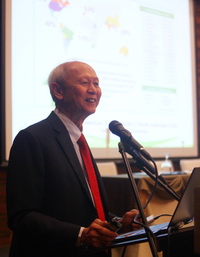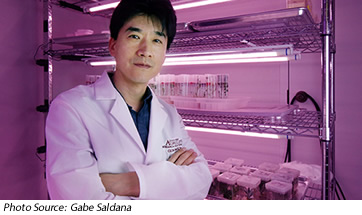CROP BIOTECH UPDATE
---------------------------------------------------------------------------
A weekly summary of world developments in agri-biotech for developing countries, produced by the Global Knowledge Center on Crop Biotechnology, International Service for the Acquisition of Agri-biotech Applications SEAsiaCenter (ISAAA)
---------------------------------------------------------------------------
July 4, 2018
In This Week’s Issue:
News
Americas
• Study Shows Labeling Reduced GMO Food Fears
• GM Tomatoes Give Fish a Pinkish Glow
Asia and the Pacific
• Biotech Corn Variety Shows Resistance to Ear Rot
• ISAAA Reports New Record-High Adoption of GM Crops
• Australian OGTR Approves Commercial Release of GM Safflower
Europe
• New Mechanism for Plant Hormone Auxin Discovered
• "GMOs Are Vital Against Hunger," Says Nobel Laureate Sir Richard J. Roberts
Research
• Arabidopsis HTT2 Improves Thermotolerance in Heading Chinese Cabbage
• OsIPMS1 Plays Key Role in Seed Vigor of Rice
New Breeding Technologies
• Application of CRISPR-Cas9 in China's Medicinal Yam
• Ms45 Homeologs Hold Key to Male Sterility in Wheat
• AgriLife Scientists Use Gene Knock in Approach for Broad Disease Resistance in Food Crops
Beyond Crop Biotech
• Chinese Scientists Complete Genome Sequencing of Tropical Sage Plant
• Scientists Develop Biological Switch to Control Genome Editing
• PagFBL1 Promotes Adventitious Root Formation in Poplar
Announcements
• Global Congress on Biotechnology
----
NEWS
----
Americas
STUDY SHOWS LABELING REDUCED GMO FOOD FEARS
A new study from the University of Vermont (UVM) reveals that a simple disclosure can improve consumer attitudes toward food products containing genetically engineered (GE) ingredients.
On July 1, 2016, a Vermont law requiring labels on all foods containing GE ingredients or genetically modified organisms (GMOs) went into effect. But the labels were required only until July 27, 2016, when a federal law superseded it.
Led by Jane Kolodinsky, an applied economist in UVM's College of Agriculture and Life Sciences, the study compared levels of consumer opposition to GMO foods in Vermont – the only U.S. state to have implemented a mandatory labeling policy – with consumer attitudes in the rest of the U.S. The analysis showed opposition to GMO food fell by 19% in Vermont after the implementation of mandatory labels. The study is the first to examine the real impact of consumer attitudes toward GMO foods where consumers were exposed to mandatory labels.
Kolodinsky's study, co-authored by Jayson Lusk of Purdue University's Department of Agricultural Economics, suggests that a simple, straightforward label disclosing whether a product is "produced or partially produced using GMO ingredients" may improve consumer confidence in GMO technologies and enable consumers to make an informed decision.
More details are available in the news articles from University of Vermont and Purdue University.
GM TOMATOES GIVE FISH A PINKISH GLOW
Salmon or trout from the wild have pink or red flesh because of their diet, which includes crustaceans or insects. However, fish raised in ponds or sea pens often have pale pink flesh due to the feeds that they take in. Thus, fish farmers add dyes derived from petroleum to the fish feed to improve the fish flesh coloration. Scientists from Royal Holloway University of London and partners developed an environment-friendly alternative to achieve the pinkish in fish flesh. Instead of making dyes from petrochemicals, they genetically engineered tomatoes to produce high levels of ketocarotenoids or high value pigments used in food and feed.
The researchers used Moneymaker tomato variety that had been genetically edited to add bacterial DNA associated with producing ketocarotenoids. Then they crossbred the modified tomatoes with another variety that expresses elevated levels of beta-carotene. This led to a new variety of tomato with high levels of ketocarotenoids. The fruits were freeze-dried and powdered then mixed into fish feed. The researchers found that the fish absorbed roughly twice as many ketocarotenoids from tomato as they did from the same amount of petrochemical-derived dye.
Read more information, read Hakai Magazine and PNAS.
Asia and the Pacific
BIOTECH CORN VARIETY SHOWS RESISTANCE TO EAR ROT
A biotech corn variety has provided a solution to a fungal disease causing losses to farmers in Bukidnon, Philippines.
Corn farmers in the uplands of Bukidnon tried planting Agrisure NK306BtGT (Event Bt11xGA21) which showed resistance to the Diplodia Ear Rot or DER, a destructive fungal disease that causes grayish or grayish brown mold in the ears or kernels, eventually resulting in the rotting of the ears. This stacked trait variety with herbicide tolerance and insect resistance traits was developed by Syngenta.
According to Rosalia Ragmac, a corn grower from Bukidnon, their corn plants had been affected by the disease for more than ten years, giving them poor harvest. Thus, they could not pay for the borrowed money to finance their five-hectare farm. Today, NK306 gives them an opportunity to improve their harvest.
Syngenta's Corn Product Selection Lead, Duanne Makabudbud, mentioned that NK306 performs favorably in upland and high elevation areas, especially where DER is prevalent. The corn variety is also resistant to stalk rot and foliar diseases and performs well even in poor soil and adverse weather conditions. It can be planted at a density of 71,000 to 80,000 plants per hectare with a potential yield of 10-12 tons per hectare.
For more details, read the original article from Zac Sarian and the Philippine Department of Agriculture memorandum on updated list of GM corn events approved for propagation.
ISAAA REPORTS NEW RECORD-HIGH ADOPTION OF GM CROPS
 The International Service for the Acquisition of Agri-biotech Applications (ISAAA) launched the annual report on the Global Status of Commercialized Biotech/GM Crops: 2017 (ISAAA Brief 53) through a media conference held on June 26, 2018 at Acacia Hotel, Manila, Philippines. The report is the 22nd of the ISAAA series of global status reports documenting the latest information on the adoption and benefits of biotech crops. The event, which was co-organized by the SEARCA Biotechnology Information Center (SEARCA BIC), presented an opportunity for media partners to connect with scientists and experts, representatives from the national government, and partners in the biotech community.
The International Service for the Acquisition of Agri-biotech Applications (ISAAA) launched the annual report on the Global Status of Commercialized Biotech/GM Crops: 2017 (ISAAA Brief 53) through a media conference held on June 26, 2018 at Acacia Hotel, Manila, Philippines. The report is the 22nd of the ISAAA series of global status reports documenting the latest information on the adoption and benefits of biotech crops. The event, which was co-organized by the SEARCA Biotechnology Information Center (SEARCA BIC), presented an opportunity for media partners to connect with scientists and experts, representatives from the national government, and partners in the biotech community.
ISAAA Board Chair, Dr. Paul Teng, presented the report, including the global impact, economic benefits, and future prospects of biotech crops. He reported that biotech crop land area reached a new record-high adoption at 189.8 million hectares worldwide in 2017. Also notable was the increase in biotech crop area in developing countries, continuously surpassing those in industrial countries in terms of total land area, with 100.6 M ha and 89.2 M ha, respectively.
Dr. Teng added that the global GM crop area is expected to expand in the coming years and that new biotech crops and traits in different parts of the globe are now in the pipeline. Highlighting the importance of regulations, Dr. Teng stated, "Science-based regulations are very important. If we cannot use science, we have no ground to stand on. It cannot be based on perceptions alone as these are often proven wrong. Science is what we have in the moment as a tool to show that something is credible." He also shared that the global farm income gains contributed by biotech crops in the last 21 years (1996-2016) have amounted to US$186.1 billion, benefitting more than 17 million farmers, 95% of whom come from developing countries.
Download the ISAAA Brief 53 Full Report, Executive Summary, Press Release, Infographics, and Presentation Slides from the ISAAA website.
AUSTRALIAN OGTR APPROVES COMMERCIAL RELEASE OF GM SAFFLOWER
 Australia's Office of the Gene Technology Regulator (OGTR) has issued license DIR 158, authorizing the commercial release of safflower genetically modified (GM) for high oleic acid composition.
Australia's Office of the Gene Technology Regulator (OGTR) has issued license DIR 158, authorizing the commercial release of safflower genetically modified (GM) for high oleic acid composition.
The GM safflower will be released throughout Australia. The GM safflower and products derived from it may enter general commerce, for use in industrial oil production and animal feed. The GM safflower will not be used in human food.
Both the risk assessment and risk management plan (RARMP) and the license were finalized after taking into account inputs received during consultation with the public, State and Territory governments, Australian Government agencies, the Minister for the Environment, the Gene Technology Technical Advisory Committee and local councils.
The RARMP, its summary, the License, and Questions and Answers about this decision are available online from the DIR 158 page of the OGTR.
Europe
NEW MECHANISM FOR PLANT HORMONE AUXIN DISCOVERED
Auxin is a key plant hormone controlling a number of processes ranging from shaping the embryo in the seed to branching of the growing plant. It is previously believed that the main signaling mechanism of auxin operated in the cell nucleus and acted only by regulating gene transcription. Now, scientists led by Jiří Friml at the Institute of Science and Technology Austria (IST Austria) showed that another mechanism exists which enables rapid adaption of root growth direction.
When seeds germinate, their roots bend to grow deeper into the soil, and in order to do this, cell growth continues on one side of the root while being inhibited on the other. This inhibition was known to be triggered by auxin and to happen very quickly, but the exact reaction times were difficult to measure. Using an innovative setup, the researchers could now measure the time roots need to react to changes in the auxin concentration precisely. They concluded that the extremely rapid adaption of growth rate was far too fast to be explained by the gene transcription mechanism, and therefore must involve a correspondingly rapid perception mechanism.
According to the researchers, the new mechanism is not entirely unknown. Components of the well-studied pathway, the TIR1 receptor, are needed for the newly discovered mechanism. Jiří Friml explains that they were able to prove that the signaling is non-transcriptional, and they have seen that components of the original transcriptional pathway are needed. "This means that we are not looking at an entirely new pathway, but at a new branch of the canonical pathway," he adds.
For more details, read the news release from IST Austria.
"GMOS ARE VITAL AGAINST HUNGER," SAYS NOBEL LAUREATE SIR RICHARD J. ROBERTS
 During the 68th Lindau Nobel Laureate Meeting held on June 24-29, 2018, Nobel Laureate Sir Richard J. Roberts delivered an Agora Talk about genetically modified organisms (GMOs) emphasizing the benefits of GMOs and how they can provide nutritious food to developing countries across the globe.
During the 68th Lindau Nobel Laureate Meeting held on June 24-29, 2018, Nobel Laureate Sir Richard J. Roberts delivered an Agora Talk about genetically modified organisms (GMOs) emphasizing the benefits of GMOs and how they can provide nutritious food to developing countries across the globe.
On June 26, 2018, Roberts, who is leading the initiative "Laureates Letter Supporting Precision Agriculture (GMOs)," a campaign of 133 Nobel Laureates supporting GMOs, delivered an impassioned speech to a room full of people. He said, "There are 800 million hungry people in the world, for them, food is like medicine!" In fact, he continues, taking a look at today's crops and vegetables, "pretty much everything we eat today has already been genetically modified compared to the original plants."
The 1993 Nobel Laureate also discussed the serious consequences of the backlash that GMOs have received. Using Golden Rice as an example, he said that deliberately ignoring the science that underpins GMOs is foolish and dangerous. Millions of children have died or suffered developmental impairment because of a lack of Vitamin A in their diet. Golden Rice could reverse this, but has become a target of the Green parties because it is a GMO. He also asked, How many more children must die before this is considered a crime against humanity?
For more details, read the blog article and view the video of the presentation at the Lindau Nobel Laureate Meeting website.
Research
ARABIDOPSIS HTT2 IMPROVES THERMOTOLERANCE IN HEADING CHINESE CABBAGE
In Arabidopsis, the HEAT-INDUCED TAS1 TARGET2 (HTT2) is an important thermotolerance gene that is silenced by ta-siR255, an siRNA. This ta-siR255 siRNA is absent from heading Chinese cabbage (Brassica rapa ssp. pekinensis). The team of Jianxia Jiang from Chinese Academy of Sciences previously attempted to overexpress the heading Chinese cabbage BrpHTT2 gene but failed due to cosuppression.
The researchers aimed to overexpress an exogenous HTT2, the Arabidopsis HTT2, in heading Chinese cabbage to improve its thermotolerance. After transforming the Arabidopsis HTT2 to heading Chinese cabbage, the researchers evaluated the transformed plants under high-temperature (38°C) and heat-shock (46°C) conditions.
The survival rate of the transformed seedlings increased compared to wildtypes under heat shock. The hypocotyl length of the transformed seedlings were also increased under high temperature and heat shock. Several heat-shock factor genes were also found to be upregulated in the transformed plants under high-temperature and heat shock conditions. In the field, the transgenic plants appeared greener and formed leafy heads earlier than wildtypes.
The study provides a new approach to the genetic manipulation of thermotolerance in crops through the introduction of exogenous genes.
For more information, read the article in BMC Plant Biology.
OSIPMS1 PLAYS KEY ROLE IN SEED VIGOR OF RICE
Seed vigor is an important trait for the direct seeding of rice. Isopropylmalate synthase (IPMS) is known to catalyze the committed step of leucine (Leu) biosynthesis, but its effect on seed vigor remains unclear. Yongqi He, together with his colleagues, studied the roles of rice OsIPMS1 and OsIPMS2 in seed vigor. Both OsIPMS1 and OsIPMS2 are known to catalyze Leu biosynthesis, and Leu feedback inhibits their IPMS activities.
Disruption of OsIPMS1 resulted in low seed vigor under various conditions, which might be associated with the reduction of amino acids in germinating seeds. Eleven amino acids that associated with stress tolerance, GA biosynthesis, and tricarboxylic acid cycle were also significantly reduced in osipms1 mutants compared with those in wildtypes during seed germination.
Analysis indicated that a total of 1,209 differentially expressed genes were altered in the osipms1 mutant compared with wildtypes at the early germination stage. Most of the genes were involved in glycolysis, protein processing, and mannose metabolism. Further analysis confirmed that the role of OsIPMS1 in seed vigor is involved in starch hydrolysis, glycolytic activity, and energy levels in germinating seeds.
This study provides novel insights into the function of OsIPMS1 on seed vigor.
For more information, read the article in Plant Biotechnology Journal.
New Breeding Technologies
APPLICATION OF CRISPR-CAS9 IN CHINA'S MEDICINAL YAM
Dioscorea zingiberensis, a type of yam in China, is a major pharmaceutical plant that produces diosgenin, a raw material for steroidal hormones. To date, there is no genome editing approach reported for D. zingiberensis. The CRISPR-Cas9 system proved to be an efficient targeted genome modification tool and has been successfully applied in many plants. The team of Shan Feng from Wuhan University in China, aimed to apply the CRISPR-Cas9 system in D. zingiberensis.
The team designed a guide RNA to target the farnesyl pyrophosphate synthase gene (Dzfps), which is a critical gene involved in the synthesis of secondary metabolites. High frequencies of mutants were detected in T0 plants. Among the transformed plants, nine mutants that contained mutations at the predicted site were identified. The transcript levels of Dzfps, was significantly decreased, leading to a decrease in the content of squalene in the isolated mutants compared to wildtype plants.
The study revealed that CRISPR-Cas9 can be an effective approach for genome modification in D. zingiberensis.
For more information, read the article in Plant Cell, Tissue and Organ Culture.
MS45 HOMEOLOGS HOLD KEY TO MALE STERILITY IN WHEAT
Identification and manipulation of male fertility genes in hexaploid bread wheat is important for understanding pollen development and to gain novel sources of nuclear genetic male sterility (NGMS). The maize Male sterile 45 (Ms45) gene has been shown to be required for male fertility. To investigate the role of Ms45 gene in wheat, the team of Manjit Singh from DuPont Pioneer induced mutations in the A, B and D homeologs of Ms45 using CRISPR-Cas9.
Several lines with various combinations of mutations were recovered, including lines with mutations in all three homeologs. Analysis of these mutants revealed that all three wheat Ms45 homeologs contribute to male fertility and that the triple mutants are required to abort pollen development and achieve male sterility. Furthermore, a wildtype copy of Ms45 gene from rice was able to restore fertility to these wheat mutant plants.
These results provide evidence on the function of MS45 function in wheat. The Ms45 gene can potentially be used for a Seed Production Technology (SPT)-like hybrid seed production system in wheat.
For more information, read the article in Plant Molecular Biology.
AGRILIFE SCIENTISTS USE GENE KNOCK IN APPROACH FOR BROAD DISEASE RESISTANCE IN FOOD CROPS
 A new gene editing technique has the potential to confer broad-spectrum disease resistance to specific staple crops without affecting other physical traits, according to a scientist from Texas A&M AgriLife Research.
A new gene editing technique has the potential to confer broad-spectrum disease resistance to specific staple crops without affecting other physical traits, according to a scientist from Texas A&M AgriLife Research.
Dr. Junqi Song, a plant pathologist in AgriLife together with his team of researchers, explores how a "knock-in" gene editing approach might achieve better disease resistance in many crop plants. Instead of switching genes off (knocking out), they used CRISPR-Cas9 system to introduce, or knock in a specific group of genetic regulators that allow disease resistance without affecting the plant.
"By comparison, the knock-in approach is a much more complicated process than knockout," Dr. Song stressed. The knock in will form an introduced system that helps the plant's existing disease resistance genes to be more efficient in countering the attacking pathogens. Dr. Song's team currently focuses on addressing late blight disease in tomato and potato but may have implications for other important food crops such as wheat, rice, cotton, strawberry, carrot, and citrus.
Read more from AgriLife Today.
Beyond Crop Biotech
CHINESE SCIENTISTS COMPLETE GENOME SEQUENCING OF TROPICAL SAGE PLANT
Chinese scientists have sequenced the tropical sage genome, which will help with breeding and growing other sage plants, most valued for their aroma and appearance.
Xin Haibo, senior engineer with the Beijing Institute of Gardening Science and a member of the research team, said establishing the plant's genetic mechanism is valuable for breeding and editing the genomes of other coordinal plants.
Tropical sage is used in public gardens all over the world. The Beijing institute has developed over 10 varieties of tropical sage. Xin said that through genetic technology, they can control the colors and timing of blossoming, and extract essential sage oil and other aromatic and medicinal components from tropical sage.
Other details available at the Chinese Academy of Sciences.
SCIENTISTS DEVELOP BIOLOGICAL SWITCH TO CONTROL GENOME EDITING
Scientists at the University of Bath and Cardiff University in UK developed an efficient biological switch that turns on protein expression at will. The switch enables control of genome editing tools which has the potential to regulate a system of favorable genetic modification through the entire populations. The results are published in Scientific Reports.
The new switching method is expected to work for any protein in any species and utilizes an inexpensive, non-toxic amino acid similar to lysine as switch. When the switch is turned on, it requires the presence of an amino acid known as BOC. Unlike other switches, the novel method does not use antibiotics, removing the risks of selecting for bacterial antibiotic resistance. The researchers successfully employed the novel switch in both cultured cells and in early-stage mouse embryos without any detectable target protein expression activity in the absence of BOC.
The method used by the researchers extends a principle known as genetic code expansion. To show this principle, the researchers used transgenic mice with a gene that makes their skin light up under UV light. When the genetic code expansion toolkit was present in embryos from the mice, their genomic DNA was edited to remove the fluorescence gene in the presence of BOC. Without BOC, there was no editing.
Read the research article for more details.
PAGFBL1 PROMOTES ADVENTITIOUS ROOT FORMATION IN POPLAR
Adventitious roots occur naturally in many species, and can also be induced from explants of some tree species including poplar, providing an important means of clonal propagation. Auxin has been identified as playing a crucial role in adventitious root formation, but the associated mechanism needs to be explored.
Led by Wenbo Shu, a Chinese Academy of Forestry research team studied the role of PagFBL1, a homolog of the Arabidopsis auxin receptor TIR1 in hybrid poplar (Populus alba × P. glandulosa clone 84K), in its adventitious root formation.
PagFBL1 expression was found to be concentrated in the cambium and secondary phloem in stems during adventitious root induction and initiation phases. Overexpressing PagFBL1 stimulated adventitious root formation and increased root biomass. Meanwhile, knockdown of PagFBL1 resulted in delayed adventitious root formation and decreased root biomass.
This study suggests that PagFBL1 promotes adventitious rooting and could be targeted to improve Populus propagation by cuttings.
For more information, read the article in Plant Biotechnology Journal.
Announcements
GLOBAL CONGRESS ON BIOTECHNOLOGY
What: Global Congress on Biotechnology
When: September 6-7, 2018
Where: Bangkok, Thailand
For more details, visit the conference website.
(c) 2024. ISAAA.
 The International Service for the Acquisition of Agri-biotech Applications (ISAAA) launched the annual report on the Global Status of Commercialized Biotech/GM Crops: 2017 (ISAAA Brief 53) through a media conference held on June 26, 2018 at Acacia Hotel, Manila, Philippines. The report is the 22nd of the ISAAA series of global status reports documenting the latest information on the adoption and benefits of biotech crops. The event, which was co-organized by the SEARCA Biotechnology Information Center (SEARCA BIC), presented an opportunity for media partners to connect with scientists and experts, representatives from the national government, and partners in the biotech community.
The International Service for the Acquisition of Agri-biotech Applications (ISAAA) launched the annual report on the Global Status of Commercialized Biotech/GM Crops: 2017 (ISAAA Brief 53) through a media conference held on June 26, 2018 at Acacia Hotel, Manila, Philippines. The report is the 22nd of the ISAAA series of global status reports documenting the latest information on the adoption and benefits of biotech crops. The event, which was co-organized by the SEARCA Biotechnology Information Center (SEARCA BIC), presented an opportunity for media partners to connect with scientists and experts, representatives from the national government, and partners in the biotech community.  Australia's Office of the Gene Technology Regulator (OGTR) has issued license DIR 158, authorizing the commercial release of safflower
Australia's Office of the Gene Technology Regulator (OGTR) has issued license DIR 158, authorizing the commercial release of safflower  During the 68th Lindau Nobel Laureate Meeting held on June 24-29, 2018, Nobel Laureate Sir Richard J. Roberts delivered an Agora Talk about
During the 68th Lindau Nobel Laureate Meeting held on June 24-29, 2018, Nobel Laureate Sir Richard J. Roberts delivered an Agora Talk about  A new
A new